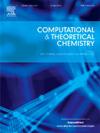A theoretical study of the effect of end-group and center backbone modifications on the optoelectronic properties of Y6-based asymmetric LL3 non-fullerene
IF 3
3区 化学
Q3 CHEMISTRY, PHYSICAL
引用次数: 0
Abstract
Y6-based non-fullerene acceptor (NFA) has garnered significant attention because of its unique A-DA'D-A molecular structure. However, the impact of asymmetric modification—a key strategy to enhance NFAs—on their photovoltaic properties is still not well understood. In this study, we optimized the high-performance asymmetric LL3, a Y6-based NFA characterized by its distinctive 3D end-group structure, by employing end-group and skeleton modification techniques. We designed six new asymmetric NFA candidates by expanding thiophene rings within the skeleton's core, incorporating π-bridges, and substituting chlorinated benzene rings or 3D segments at the end-groups with thiophene. Using density functional theory (DFT) and time-dependent DFT (TD-DFT), we calculated various molecular properties of these NFAs, such as molecular planarity, dipole moments, frontier molecular orbitals, electrostatic potential (ESP), electron-hole distributions, UV–Visible absorption spectra, singlet-triplet energy difference (ΔEST), exciton binding energy (Eb), and the open circuit voltages of organic solar cells based on these NFAs. Our results show that five of the new NFAs outperform the prototype LL3, with LL3-T-L standing out due to its red-shifted absorption peak, highest light absorption intensity, lower ΔEST and Eb, and enhanced ESP, indicating its potential as a high-performance NFA. These findings provide theoretical guidance for future experimental synthesis and device optimization.

y6基不对称LL3非富勒烯端基和中心主链修饰对其光电性能影响的理论研究
y6基非富勒烯受体(NFA)因其独特的A-DA'D-A分子结构而备受关注。然而,不对称修饰(增强nfas的关键策略)对其光伏性能的影响仍未得到很好的理解。在本研究中,我们采用端基和骨架修饰技术,对具有独特的三维端基结构的y6基NFA高性能非对称LL3进行了优化。我们设计了六个新的非对称NFA候选分子,通过扩展骨架核心的噻吩环,加入π桥,并在端基上用噻吩取代氯化苯环或三维段。利用密度泛函理论(DFT)和时变DFT (TD-DFT)计算了这些nfa的各种分子性质,如分子平面度、偶极矩、前沿分子轨道、静电势(ESP)、电子空穴分布、紫外-可见吸收光谱、单重态-三重态能差(ΔEST)、激子结合能(Eb)以及基于这些nfa的有机太阳能电池的开路电压。结果表明,其中5种新型NFA的性能优于原型LL3,其中LL3- t - l因其红移吸收峰,最高的光吸收强度,较低的ΔEST和Eb以及增强的ESP而脱颖而出,表明其具有高性能NFA的潜力。这些发现为今后的实验合成和器件优化提供了理论指导。
本文章由计算机程序翻译,如有差异,请以英文原文为准。
求助全文
约1分钟内获得全文
求助全文
来源期刊

Computational and Theoretical Chemistry
CHEMISTRY, PHYSICAL-
CiteScore
4.20
自引率
10.70%
发文量
331
审稿时长
31 days
期刊介绍:
Computational and Theoretical Chemistry publishes high quality, original reports of significance in computational and theoretical chemistry including those that deal with problems of structure, properties, energetics, weak interactions, reaction mechanisms, catalysis, and reaction rates involving atoms, molecules, clusters, surfaces, and bulk matter.
 求助内容:
求助内容: 应助结果提醒方式:
应助结果提醒方式:


